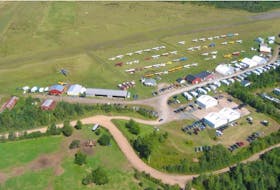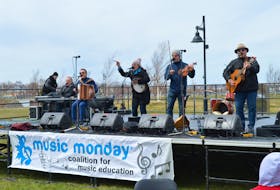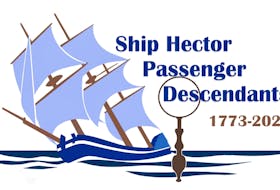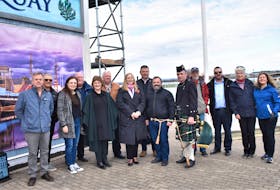If the ghosts on McNabs island could talk they’d tell tales of Hangman’s Beach where criminals were left to rot in gibbets. They’d talk about dying of cholera and lying in graves that washed out to sea.
They’d also tell stories of happier days: the fair grounds, the dance halls the Prohibition-era soda pop factory which rumours have it (wink-wink) produced some drinks that were stronger than others.
Most visitors who set foot on McNabs have lived across the harbour for years without realizing its depth of history, the houses, forts, guns and stories it has to offer. Or that it’s a provincial park.
“I knew nothing other than it was an island in Halifax Harbour and then I read a little bit and found there used to be a (fair) here and a soda pop plant. I was like, really? All that under my nose and I didn’t even see it,” said Susan Skinner, who along with her husband David, was on a recent tour the Friends of McNabs Society. “I’m just delighted to be here.”
David was equally in awe of what he discovered on McNabs and its natural charms. Once a popular fishing stop for Mi’kmaq, through the centuries it was a thriving community for military watching the harbour and civilians getting away from the city.
“You don’t know what’s in your backyard,” David said. “It’s so beautiful.”
Volunteer tour guide with the society, Royce Walker gets that a lot. He estimates 12,000-15,000 people visit a year, most of them local and often seeing the island for the first time.
“Lots of people live in the region and have always said ‘must go’ but haven’t,” he said. “They’re not aware that it’s a provincial park often and many people are not aware that it’s open for use.”
On weekends through the summer and into the fall, the society hosts full-day tours of the island, charging only the cost of the ferry ride over. Tours sell out fast.
Shipwrecks
Walker points out the guts of shipwrecks sticking out of the water like a ribcage of an ancient beast just off shore on the north end of the island. McNabs is unique because there are so many wrecks in shallow water that people who don’t mind getting a little wet, can walk out and touch them.
“There is a ring of them around the island with a few fairly significant ones,” he said. “A lot of the wrecks are dumped and they were deliberately scuttled around the island so they’re not necessarily a shipwreck due to a disaster but it still adds some history and features to the shoreline.”
Fort Ives
Fort Ives with its guns, tunnels and structures now being reclaimed by nature, draws plenty of attention from visitors, but it’s the story Walker weaves which brings out surprised gasps and a few laughs from the group.
Constsructon of Fort Ives started in 1864 to protect the channel between McNabs and York Redoubt. Fort McNabs, a national historic site, on the other end of the island is much larger and more intact.
Halifax was never attacked, of course, but Walker said that doesn’t mean shots were never fired from McNabs.

On March 1, 1919 “There was a little boat out tending buoys … The fort had a rule that said any boat that came past the fort that we haven’t been notified about by the navy, we’re going to shoot at,” Walker explained. “The little boat comes past the fort (Ives), headed for another job around the corner and the fort doesn’t have any word so they fire a blank. The skipper on the Brant, it was called, had just gone down for lunch. He heard the bang and thought, ‘Oh, noon-time gun going off.’”
Another round was fired in the direction of the ship and a navy vessel came alongside. The skipper explained the situation and everything was fine. Except ...
“The shell missed the Brant, hit the water and what happens when you skip a stone? It skipped into Halifax and hit a house on (Lucknow Street),” Walker continued as the group reacted with a bit of shock, half expecting to hear next about death and mayhem.
“The mom and dad were out, the maid was hanging clothes and the daughter was horseback riding so there was a whistling sound of an incoming shell and bam! In through the roof of the house.”
No one was hurt, and the house didn’t catch on fire but since it was wartime, people suspected Germans were attacking. Those concerns were quickly put to rest.
A summer place

There are three boarded up, but still standing historical houses on the island. These are reminders of the people who lived on the island as tenant farmers or summer vacationers.
Perhaps the most famous is the summer home of A.J. Davis. A successful Halifax butcher, Davis built the house in 1912 then later built his soda pop factory on the island.
“He would come over here to get away from all the heat and the dust in the city but he also bought into the fairgrounds that were on the island,” he said.
Earlier this summer, Davis’ descendants fromall over North America visited McNabs.
“It was fun to bring them over and show them the house,” Walker said.
He added he often gets calls from people with family connections to the island, who had ancestors who were cholera victims or military personnel who were stationed here.
The last full time resident of Davis’ old summer home was Gladys Conrad, sister of midway king Bill Lynch. When the fairground on the island slowed to a stop in the early 1920s, Lynch took it off the island and started touring it through the region.
“It’s pretty amazing,” said Tammy Fleming. “The fact that Bill Lynch was here. I grew up going to the fair and stuff, so that’s pretty cool I thought.”
Fleming, from Middle Sackville, has lived in the area her whole life and had never been to McNabs. She was awestruck by all she learned on the tour.
“I just never realized you could come here and it was just an island. Over the past few years I’ve known people who have done tours here and I thought it would be cool to do one.”
Stories of hangmans beach and cholera
Peter McNab, who bought the island from the Cornwallis family in 1782 for an outrageous sum of 1,000 sterling, took issue with the British hanging the dead bodies of deserters and criminals on Maugher Beach. Legend has it on one stormy night he enlisted his tenants to cut down the gibbets and destroy them. The British soon gave up the practice, instead deciding to build a martello tower in the area instead. A lighthouse sits on the spot today.

In April, 1866 the SS England with 1,202 passengers onboard, many of them sick with cholera, sought refuge in Halifax but were denied, The sick were taken to a naval ship and the healthy were taken to McNabs to scramble for food and shelter. After the crisis passed, the ship sailed off to New York leaving behind about 200 people who were buried on McNabs. Many of the graves were washed out to sea.
Mi’kmaq
Besides acknowledging McNabs is ancestral and unceded Mi’kmaq territory, there’s not much information on the Mi’kmaq people’s time on the island.
“We don’t know a lot and shame on us for that,” Walker said in an interview. “That’s part of the story we need to do more work on.”
A summer student started research on the topic last year but still there’s not a lot of information.
“We know they were here because there’s a shell midden on the island so that’s basically a garbage dump that would be at their campsite. It’s typically shellfish shells that get left behind.”
Climate change
Look no farther than the beaches on McNabs to see the effects of climate change.
In 2003, Hurricane Juan caused considerable damage to the island but it has also been shaped by more recent storms.
“The beach has been eroding here relatively rapidly and the telephone poles began to tip over and two winters ago we had four significant storms that broke power poles and laid some of them down,” Walker said.
The telephone poles that used to be between the road and the beach are now past the road and further inland.
The beach has been reshaped and often it looks very different even after a few months.
“Just a significant winter can make a big change,” Walker said.
McNabs now

The Friends of McNabs Society is seeking government funds to restore and conserve the three historical houses on the island. The society also has plans to turn a 1980s abandoned tea house into an outdoor education centre.
Most of McNabs is managed by the provincial and federal governments but there are also a few privately-owned lots.

Tour information: To find out about upcoming tours as well as other ways to get to McNabs Island, visit mcnabsisland.ca








